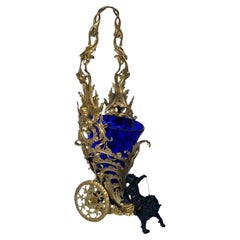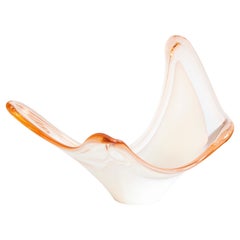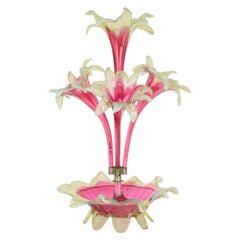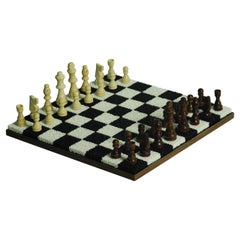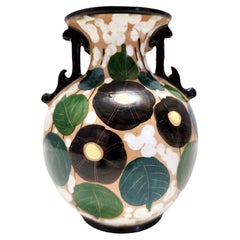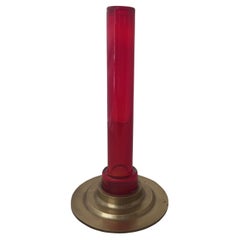Italian Centerpieces
13
to
1
4
2
13
13
13
8
1
12
38
934
627
30
496
345
4
1
13
52
53
92
113
166
82
34
10
7
3
2
1
95
32
13
12
11
1
Period: 1920s
Place of Origin: Italian
Early 20th Century Italian Bronze Centerpiece
Located in Los Angeles, CA
Early 20th century Italian two-tone bronze centerpiece on a gold hue with an overall ornate open work design, accented with a figurative chariot of a putti angel mounted on top of a ...
Category
1920s Other Vintage Italian Centerpieces
Materials
Bronze
Vintage Large Hand-Painted Earthenware Vide-Poche / Decorative Plate, Italy
Located in Bresso, Lombardy
Made in Italy, 1920s.
This catchall / vide-poche / decorative plate is made in hand-painted and glazed earthenware with black and goldenrod floral motifs.
It has a shiny finish.
Thi...
Category
1920s Mid-Century Modern Vintage Italian Centerpieces
Materials
Earthenware
Murano, 1920, Italian
Located in Ciudad Autónoma Buenos Aires, C
Murano
We have specialized in the sale of Art Deco and Art Nouveau and Vintage styles since 1982. If you have any questions we are at your disposal.
Pushing the button that reads 'View All From Seller'. And you can see more objects to the style for sale.
Why are there so many antiques in Argentina?
In the 1880 – 1940 there was a grate wave of immigration encouraged by the periods of war that were taking place.
1st World War took place between 1914 and 1918
2nd World War took place between 1939 and 1945
The immigrants options were New York or Buenos Aires. Tickets were cheap and in Buenos Aires they were welcomed with open arms, as it was a country where everything was still to be done.
Argentina was the country of new opportunities, labour was needed and religious freedom was assured, in many cases the of the family travel first until they were settled and then the rest of the family members join them.
In the immigrant museum “Ellis Island Immigrant Building” in New York you can se the promotional posters of the boats that would take them to a new life.
Between the years 1895 and 1896, Argentina had the highest DGP (gross domestic product) per capita in the world according to the Maddison Historical Statistics index, this situation arose due to the large amount of food being exported to European countries, which were at war.
The Argentinean ships left the port of Buenos Aires with food, but they returned with furniture, clothes and construction elements, (it´s common to see this the old buildings of the historic neighbourhood of San Telmo, the beams with the inscription “Made in England)”, as well as many markets that were built in Buenos Aires, such us the San Telmo Market, whose structure was brought by ship and afterwards assembled in 900 Defensa Street.
With the great influence of European immigrants living in the country, the children of the upper classes travelled to study in France, resulting in the inauguration of “La Maison Argentinienne”, on 27th of June 1928, in the international city of Paris, which hosted many Argentinians that were studying in Frace.
It´s the fourth house to be built after France, Canada and Belgium, being the first Spanish-speaking one. Still in place today (17 Bd Jourdan, 75014, Paris, France). Many of the children of these wealthy families who attended international art exhibitions, museums and art courses abroad, took a keen interest in the European style. This is why Buenos Aires was at the time referred as “The Paris of South America”.
Between the years 1890 and 1920 more than a hundred Palaces were built on Alvear Avenue the most exclusive avenue in Buenos Aires. Today some of these palaces have been transformed into museums, hotels and embassies.
In the year 1936, the Kavanagh building was inaugurated, it was the tallest reinforced concrete building in South America.
During 1994 the American Society of Civil Engineers distinguished it as an “international engineering milestone”, and it´s now considered a World Heritage of Modern Architecture.
At the time was common to hire foreign architects such as Le Corbusier, who visited Buenos Aires/Argentina in 1929 and in 1948 he drew up the blueprints for a house built in La Plata City (which was declared a World Heritage Site).
In 1947, the Hungarian architect Marcelo Breuer designed “Parador Ariston” in the seaside city of Mar del Plata. After an Argentinean student at Harvard University convinced him to come to Argentina. He worked on an urban development project in the Casa Amarilla, area of La Boca.
The Ukrainian architect, Vladimiro Acosta, arrives in Argentina in 1928 and worked as an architect until que moved to Brazil.
Antonio Bonet, a Spanish architect who worked with Le Corbusier in Paris, arrives in Argentina in 1937, where he carried out several architectural works and in 1938 designs the well-known BFK chair.
Andres Kálnay, of Hungarian origin, made around 120 architectural masterpieces, among which the former Munich brewery stands out, he even made the furniture’s design.
The German architect, Walter Gropius, director of the Bauhaus, lived in Argentina, where he wrote articles for “Sur” magazine and founded in Buenos Aires, an architectural firm with Franz Möller, who was also an architect, where he built two houses.
At the same time several famous designers decided to immigrate to Argentina, among them we can find the well-known French designer, Jean-Michel Frank, who arrived in the country in 1940 and also worked for the Rockefeller family.
Special pieces were made, which were sold exclusively in the country, such as the well-known German company “WMF”, who sold their products by catalogue, which were chosen by the ladies of high society in the list of wedding gifts, as well as the pieces designed by Christofle.
The Swiss sculptor Alberto Giacometti, made special pieces for Argentinean mansions.
In 1904 the first Jansen branch outside Paris was established in Buenos Aires, as the Argentinean clientele demanded a large amount of furniture, from the end of the 19th century to the mid-20th century.
In 1970, the brand Rigolleau Argentina made pieces authorised by Lalique.
The brands Maple and Thompson also set up shop in the country.
The French plastic artist, Marcel Duchamp moved to Argentina in 1918-1919.
Glass signed Gallé, Charder, Leverre, Schneider, Muller and other French firms. They were bought in flower shops and were given to ladies with beautiful floral arrangements.
Some furniture manufacturers travelled to international fairs and bough the patterns to produce the furniture in Argentina, such as the furniture firm Englander and Bonta, who bought the patterns ins Italy.
It is worth mentioning that in Argentina we have the largest community of Italians outside...
Category
1920s Art Deco Vintage Italian Centerpieces
Materials
Murano Glass
Big Murano, 1920, Italian
Located in Ciudad Autónoma Buenos Aires, C
Murano
We have specialized in the sale of Art Deco and Art Nouveau and Vintage styles since 1982. If you have any questions we are at your disposal.
Pushing the button that reads 'View All From Seller'. And you can see more objects to the style for sale.
Why are there so many antiques in Argentina?
In the 1880 – 1940 there was a grate wave of immigration encouraged by the periods of war that were taking place.
1st World War took place between 1914 and 1918
2nd World War took place between 1939 and 1945
The immigrants options were New York or Buenos Aires. Tickets were cheap and in Buenos Aires they were welcomed with open arms, as it was a country where everything was still to be done.
Argentina was the country of new opportunities, labour was needed and religious freedom was assured, in many cases the of the family travel first until they were settled and then the rest of the family members join them.
In the immigrant museum “Ellis Island Immigrant Building” in New York you can se the promotional posters of the boats that would take them to a new life.
Between the years 1895 and 1896, Argentina had the highest DGP (gross domestic product) per capita in the world according to the Maddison Historical Statistics index, this situation arose due to the large amount of food being exported to European countries, which were at war.
The Argentinean ships left the port of Buenos Aires with food, but they returned with furniture, clothes and construction elements, (it´s common to see this the old buildings of the historic neighbourhood of San Telmo, the beams with the inscription “Made in England)”, as well as many markets that were built in Buenos Aires, such us the San Telmo Market, whose structure was brought by ship and afterwards assembled in 900 Defensa Street.
With the great influence of European immigrants living in the country, the children of the upper classes travelled to study in France, resulting in the inauguration of “La Maison Argentinienne”, on 27th of June 1928, in the international city of Paris, which hosted many Argentinians that were studying in Frace.
It´s the fourth house to be built after France, Canada and Belgium, being the first Spanish-speaking one. Still in place today (17 Bd Jourdan, 75014, Paris, France). Many of the children of these wealthy families who attended international art exhibitions, museums and art courses abroad, took a keen interest in the European style. This is why Buenos Aires was at the time referred as “The Paris of South America”.
Between the years 1890 and 1920 more than a hundred Palaces were built on Alvear Avenue the most exclusive avenue in Buenos Aires. Today some of these palaces have been transformed into museums, hotels and embassies.
In the year 1936, the Kavanagh building was inaugurated, it was the tallest reinforced concrete building in South America.
During 1994 the American Society of Civil Engineers distinguished it as an “international engineering milestone”, and it´s now considered a World Heritage of Modern Architecture.
At the time was common to hire foreign architects such as Le Corbusier, who visited Buenos Aires/Argentina in 1929 and in 1948 he drew up the blueprints for a house built in La Plata City (which was declared a World Heritage Site).
In 1947, the Hungarian architect Marcelo Breuer designed “Parador Ariston” in the seaside city of Mar del Plata. After an Argentinean student at Harvard University convinced him to come to Argentina. He worked on an urban development project in the Casa Amarilla, area of La Boca.
The Ukrainian architect, Vladimiro Acosta, arrives in Argentina in 1928 and worked as an architect until que moved to Brazil.
Antonio Bonet, a Spanish architect who worked with Le Corbusier in Paris, arrives in Argentina in 1937, where he carried out several architectural works and in 1938 designs the well-known BFK chair.
Andres Kálnay, of Hungarian origin, made around 120 architectural masterpieces, among which the former Munich brewery stands out, he even made the furniture’s design.
The German architect, Walter Gropius, director of the Bauhaus, lived in Argentina, where he wrote articles for “Sur” magazine and founded in Buenos Aires, an architectural firm with Franz Möller, who was also an architect, where he built two houses.
At the same time several famous designers decided to immigrate to Argentina, among them we can find the well-known French designer, Jean-Michel Frank, who arrived in the country in 1940 and also worked for the Rockefeller family.
Special pieces were made, which were sold exclusively in the country, such as the well-known German company “WMF”, who sold their products by catalogue, which were chosen by the ladies of High Society in the list of wedding gifts, as well as the pieces designed by Christofle.
The Swiss sculptor Alberto Giacometti, made special pieces for Argentinean mansions.
In 1904 the first Jansen branch outside Paris was established in Buenos Aires, as the Argentinean clientele demanded a large amount of furniture, from the end of the 19th century to the mid-20th century.
In 1970, the brand Rigolleau Argentina made pieces authorised by Lalique.
The brands Maple and Thompson also set up shop in the country.
The French plastic artist, Marcel Duchamp moved to Argentina in 1918-1919.
Glass signed Gallé, Charder, Leverre, Schneider, Muller and other French firms. They were bought in flower shops and were given to ladies with beautiful floral arrangements.
Some furniture manufacturers travelled to international fairs and bough the patterns to produce the furniture in Argentina, such as the furniture firm Englander and Bonta, who bought the patterns ins Italy.
It is worth mentioning that in Argentina we have the largest Community of Italians outside...
Category
1920s Art Deco Vintage Italian Centerpieces
Materials
Murano Glass
Murano, 1920, Italian
Located in Ciudad Autónoma Buenos Aires, C
Murano
We have specialized in the sale of Art Deco and Art Nouveau and Vintage styles since 1982. If you have any questions we are at your disposal.
Pushing the button that reads 'V...
Category
1920s Art Deco Vintage Italian Centerpieces
Materials
Murano Glass
Murano , 1920, Italian.
Located in Ciudad Autónoma Buenos Aires, C
Murano
We have specialized in the sale of Art Deco and Art Nouveau and Vintage styles since 1982. If you have any questions we are at your disposal.
Pushing the button that reads 'V...
Category
1920s Art Deco Vintage Italian Centerpieces
Materials
Murano Glass
Pair of Muranos , 1920, Italian. Label Murano 'Venezia' Made in Italy
Located in Ciudad Autónoma Buenos Aires, C
Murano
We have specialized in the sale of Art Deco and Art Nouveau and Vintage styles since 1982. If you have any questions we are at your disposal.
Pushing the button that reads 'V...
Category
1920s Art Deco Vintage Italian Centerpieces
Materials
Murano Glass
Murano, 1920, Italian
Located in Ciudad Autónoma Buenos Aires, C
Murano
We have specialized in the sale of Art Deco and Art Nouveau and Vintage styles since 1982. If you have any questions we are at your disposal.
Pushing the button that reads 'V...
Category
1920s Art Deco Vintage Italian Centerpieces
Materials
Murano Glass
Mortar in order to grind in Murano, 1920, Italian
Located in Ciudad Autónoma Buenos Aires, C
Murano
We have specialized in the sale of Art Deco and Art Nouveau and Vintage styles since 1982. If you have any questions we are at your disposal.
Pushing the button that reads 'Vi...
Category
1920s Art Deco Vintage Italian Centerpieces
Materials
Murano Glass
Zaccagnini Wall Plate/Centerpiece Ceramic, 1930, Italy
Located in Milano, IT
Zaccagnini wall plate/centerpiece Ceramic, 1930, Italy.
Category
1920s Art Deco Vintage Italian Centerpieces
Materials
Ceramic
5 Pc. Venetian Centerpiece Set Candlesticks w/ Gold Leaf Applied Pink Roses
By Antonio Salviati
Located in Great Barrington, MA
Attributed to Salviati, this set of four hand blown candlesticks and matching footed centerpiece, will be the focal point of any table setting....
Category
1920s Vintage Italian Centerpieces
Materials
Blown Glass
Three-Piece Set Amethyst & Gold Figural Swan Venetian Candlesticks & Centrepiece
By Antonio Salviati
Located in Great Barrington, MA
Your table will be magnificent when you set it with this three-piece centrepiece set of handblown Venetian glass. The unusual and rare color of amethys...
Category
1920s Vintage Italian Centerpieces
Materials
Blown Glass
Rubboli Lustre Majolica Double-Handled Compote with Mask Head Detail
By Rubboli
Located in Cincinnati, OH
This early 20th century piece of Italian lustreware was made by the renowned Rubboli family pottery in the Umbrian town of Gualdo Tadino, Italy. Italian lustreware Majolica production traces its origins to the Renaissance. The art was revived in Gualdo Tadino during the last quarter of the 19th century, largely due to the efforts of ceramist Paolo Rubboli. Rubboli established his pottery in the region around 1870, and became known for the high quality of his distinctive cobalt, red and gold Neo-Renaissance lustreware.
Rubboli's wife Daria and sons Lorenzo and Alberto continued Paolo's efforts after his death in 1890, and joined the newly formed consortium Societa Ceramica Umbria in 1920. Rubboli pieces dating to the period are marked with a blue underglaze "SCU" in a triangle mark along with a conjoined "PR" monogram in homage to Paolo's work.
This large ceramic Neo-Renaissance Rubboli double handled compote is finished in cobalt, red and gold lustre. The piece consists of a round bowl at the top with elongated applied handles at either side, all of which rest upon a pedestal base. The bowl features two bas-relief winged mask heads on the exterior which have been depicted with open mouths sprouting handles in the form of serpent-like forked tongues. The exterior is also painted with pairs of imposing gryphons, each of which flank a large urn. The interior of the bowl is also heavily decorated and bears a fantastical winged lion set at the center of a series of scrolling acanthus leaves and urns, best seen in image 8. The remainder of the piece is finished with foliate and geometric motifs.
It is of note that a similar piece was included in the traveling exhibit of important Majolica and lusterware entitled 'The Rubboli Collection - Italian lustre pottery in Gualdo Tadino' held in the Chiesa Monumentale di San Francesco between July 17 – October 3, 2010.
The compote is in excellent original condition with no restorations or repairs. There are some glaze skips present on the piece as well as minor chips at the base of the pedestal foot which do not detract from the appearance of the compote and are mentioned for accuracy. The underside of the piece bears the blue underglaze Rubboli family Società Ceramica Umbra mark cited above consisting of the letters “SCU” within a triangle along with the entwined Paolo Rubboli 'PR' monogram, which was used from 1920 to 1931.
The 3lb 5oz compote stands...
Category
1920s Renaissance Revival Vintage Italian Centerpieces
Materials
Ceramic
Related Items
Italian Wine Colored Centerpiece in Murano Glass, Early 20th Century
Located in Prato, IT
Murano, Venezia, Italy, early 20th century
Spectacular Murano glass centerpiece with tray and 4 flowers.
The glass is hand blown and artfully crafted using opal and clear glass.
Category
Early 20th Century Italian Centerpieces
Materials
Art Glass
Black + White Porous Ceramic Chess + Checkers Board, Wooden Pieces, Walnut Edge
By Jordan Keaney
Located in London, GB
Porous ceramic chess and checkers set with pieces. This simple game would make a lovely, light-hearted yet sophisticated gift.
Ceramic is very delica...
Category
21st Century and Contemporary Italian Centerpieces
Materials
Ceramic, Cork
H 1.11 in W 13 in D 13 in
Decorative Handmade Cast Brass Leaf Vide Poche, Large
By Alguacil & Perkoff Ltd.
Located in London, GB
Each of these splendid brass leaves is handmade individually with incredible detail. Cast using very traditional techniques, they are polished capturing the raw finish of this noble ...
Category
2010s Organic Modern Italian Centerpieces
Materials
Brass
Large Hand Carved Rock Crystal Quartz Decorative Bowl from Brazil
Located in Dallas, TX
This important hand carved rock crystal bowl was crafted in Brazil, the heavy dish with natural scalloped edges is in excellent condition with a rich patinated clear finish. Place th...
Category
2010s Italian Centerpieces
Materials
Rock Crystal
20th Century British Solid Silver 'Rifle Regiment' Centrepieces, c.1961
Located in Royal Tunbridge Wells, Kent
Impressive mid-20th century British one of a kind military centerpieces, each modelled as a quiver of arrows supporting a laurel wreath, on a recumbent writhen dragon, mounted to an ...
Category
20th Century Italian Centerpieces
Materials
Sterling Silver
Free Shipping
H 13 in Dm 6.3 in
Mid-20th Century Italian Majolica Lemon Topiary Centerpiece
Located in Pearland, TX
A lovely Mid-Century Italian majolica basket of lemons topiary centerpiece. Freshen up your kitchen or breakfast room with this charming hand painted arrangement of lemons accented b...
Category
Mid-20th Century Italian Centerpieces
Materials
Majolica
Large Nautical Bronze Ship's Propeller, 1970s
Located in Nantucket, MA
A large, bronze propeller from a 1970s lifeboat. Great patina. We had it mounted on a custom-made iron stand to turn it into a great sculpture.
These also make great centerpieces ...
Category
Mid-20th Century Industrial Italian Centerpieces
Materials
Bronze
Antique 19th Century French Monumental Solid Silver Figural Centrepiece, c. 1880
By Christofle
Located in Royal Tunbridge Wells, Kent
Antique 19th century French monumental solid silver statue, standing on a marble base, the statue realistically modelled as a cast figure of Mary ...
Category
19th Century Antique Italian Centerpieces
Materials
Marble, Silver
Free Shipping
H 19.69 in Dm 5.91 in
Midcentury Willy Rizzo Chrome and Brass Vide-Poche, Italy, 1970s
By Willy Rizzo
Located in Roma, IT
Gorgeous Vide-Poche fully made in chrome and brass. This fantastic piece was designed in Italy during the 1970s and is attributed to a Willy Rizzo production.
This lovely decorati...
Category
Late 20th Century Mid-Century Modern Italian Centerpieces
Materials
Brass, Metal, Chrome
Mid-20th Century Italian Majolica Lemon Topiary Centerpiece
Located in Pearland, TX
A lovely Mid Century Italian majolica lemon topiary centerpiece. Signed "Italy" on reverse. Brighten up your kitchen or dining room with this beautiful hand painted arrangement of le...
Category
Mid-20th Century Italian Centerpieces
Materials
Majolica
Traditional Wooden Artist Mannequin Model Doll Vintage Italy, 1920s
Located in Nuernberg, DE
A handmade wooden Artist mannequin model - all joints move as they should. Found on a Estate sale in Verona, Italy.
Shows some wear - but looks beautiful on display! Some scratches a...
Category
Early 20th Century Folk Art Italian Centerpieces
Materials
Metal
Massive Estate Baccarat Crystal Centerpiece, Early 20th Century
By Baccarat
Located in New York, NY
Large, substantial Baccarat crystal centerpiece of circular form and bold facet design. This piece pairs well with Harcourt and is ideal f...
Category
Early 20th Century Italian Centerpieces
Materials
Crystal
Previously Available Items
Vintage Liberty Handmade and Hand-painted Earthenware Vase by Albisola, Italy
By Ceramiche di Albisola
Located in Bresso, Lombardy
Made in Italy, 1920s.
It is made in handmade ceramic, which is hand-painted.
This is a vintage piece, therefore it might show slight traces of use, but it can be considered as in v...
Category
1920s Mid-Century Modern Vintage Italian Centerpieces
Materials
Earthenware
Vase in Murano, 1920, Italian.
Located in Ciudad Autónoma Buenos Aires, C
Murano
We have specialized in the sale of Art Deco and Art Nouveau and Vintage styles since 1982. If you have any questions we are at your disposal.
Pushing the button that reads 'V...
Category
1920s Art Deco Vintage Italian Centerpieces
Materials
Bronze
20th Century Elegant Centrepiece in Crystal and Gilded Bronze
Located in Casale Monferrato, IT
Luxurious finely worked crystal centrepiece. Beautiful work with birds. The feet are enriched by golden and chiselled bronzes. This centrepiece will make your table even more elegant.
Category
1920s Vintage Italian Centerpieces
Materials
Crystal
Salviati Venetian Ruby Red Glass Gold Enamaled Kantharos, Italy
By Compagnia Di Venezia E Murano (C.V.M.), Salvati
Located in Antwerp, BE
Large red handblown ruby red Kantharos Italian Venetian gold enameled, strangeness and fantasy glass design, inspired by Salviati on seventeenth-century Venetian glass at the National Gallery of Victoria.
This whimsical Kantharos is decorated with applied glass clearer with 24-karat gold leaf inserts.
This delightful Venetian glass object...
Category
1920s Mid-Century Modern Vintage Italian Centerpieces
Materials
Enamel
Salviati Light Pink and Copper Aventurine Murano Glass Large Bowl
By Salviati
Located in Miami, FL
This Art Deco hand blown Venetian art glass centerpiece features pinwheel stripes of soft, pastel pink ribbons and copper aventurine. A gorgeous vintage centerpiece with masterfully ...
Category
1920s Art Deco Vintage Italian Centerpieces
Materials
Blown Glass
Vintage Murano Glass Decorative Centerpiece Set
Located in Tarry Town, NY
Vintage Murano glass three-piece decorative centerpiece set. Excellent condition. The large centerpiece measures 13 inches long x 10 inches width x 4 inches high. Each candlestick ho...
Category
1920s Vintage Italian Centerpieces
Materials
Murano Glass
Vintage Large Murano Decorative Centerpiece
Located in Tarry Town, NY
Vintage large Murano decorative centerpiece. The piece measure 20 inches length x 8 inches width X 7 inches high.
Category
1920s Vintage Italian Centerpieces
1920s Italian Pair of Gold Murano Glass Bowls with Cover Attributed to Zecchin
By Vittorio Zecchin
Located in New York, NY
Exquisite pair of Art Deco mostardiere: Special Italian pots with cover to keep preserved fruits, in blown amber Murano glass of the highest quality, with a smoked tint, raised on a ...
Category
1920s Art Deco Vintage Italian Centerpieces
Materials
Blown Glass, Murano Glass
19th Century Ironstone Compote Filled with Stone Fruit
Located in Essex, MA
A 19th century English Staffordshire white ironstone compote filled with a collection of 18 pieces of alabaster stone fruit and vegetables, inclu...
Category
1920s Vintage Italian Centerpieces
Materials
Alabaster
Massive Art Deco Venini Glassworks Centerpiece
By Napoleone Martinuzzi
Located in Litchfield, CT
Circa 1925, by Napoleone Martinuzzi for the Venini Glassworks, on Murano Island, Venice, Italy. This spectacular centerpiece is a masterwork of early twentieth-century Italian glass...
Category
1920s Vintage Italian Centerpieces
Materials
Blown Glass
Recently Viewed
View AllMore Ways To Browse
E Ellis
Epergne Basket
Amber Italian Centerpiece
Extra Large Centerpiece
Centerpiece Porcelain Fruit
Glass Epergnes
Footed Compotes
German Art Deco Silver Cutlery
Antique Glass Vintage Glass Candle Holders
I Miss You Vintage
Punch Card
Bronze Surtout
Wmf Cutlery
French Porcelain Centrepiece
Doctor Scale
Doctors Scale
Green Glass Bowls
Art Deco Place Card Holders
